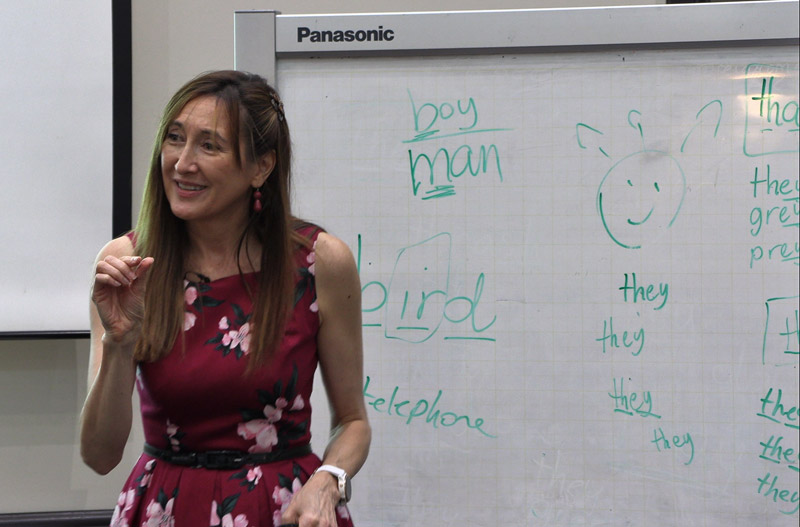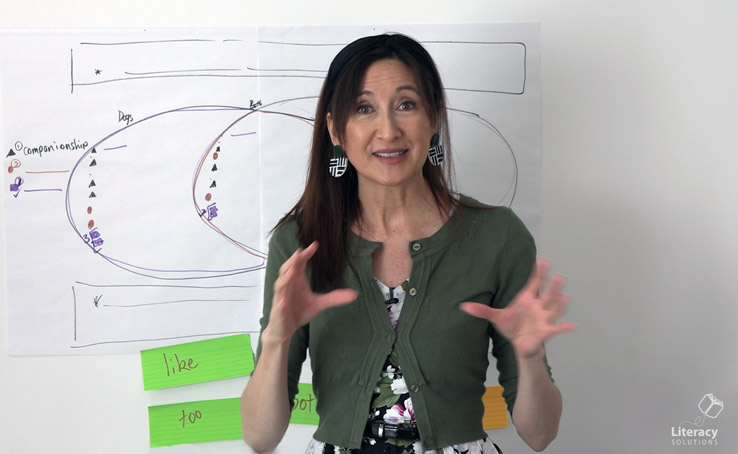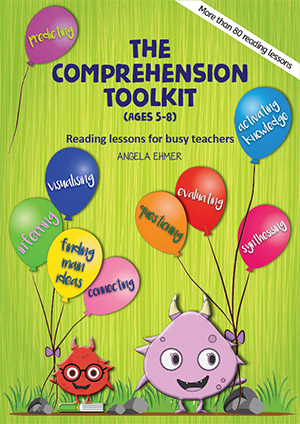Oral Language: planning for explicit instruction using relevant and authentic experiences

Education should develop children’s capacities to become effective communicators, to understand the ideas of others and to communicate ideas in a meaningful way. Developing proficiency across speaking, listening, reading and writing is central to every child’s educational journey and begins with a child’s earliest school experiences.
All children arrive at Prep with different experiences and understandings about language and literacy, acquired in their early years. Some children arrive ready to begin formal reading instruction; others require more rigorous and focused attention to aspects of oral language and pre-reading skills, in order to make a smooth transition into literacy.
To determine a starting point for each child, teachers gather formative data, diagnostic data, or both, early in the school year. These data should be recorded, analysed and used to inform appropriate teaching-learning episodes. Aligning learning goals with children’s interests and experiences ensures instruction is meaningful and relevant to the child.
What types of learning experiences may be required?
Teachers understand a strong foundation in oral language assists most children to transition more smoothly into print. Specific data relating to phonological knowledge, vocabulary, grammar, expressive and receptive language skills and book knowledge, assists teachers to plan for meaningful interactions which consolidate existing skills and develop the skills and knowledge a child needs to become literate.
Whole class instruction begins early, as does differentiation and individualised programming. Focussed oral language instruction may involve reading and revisiting focus picture books to:
- extend vocabulary
- develop phonological knowledge, such as recognition and reproduction of rhyming words
- develop concepts of print
- foster conversations
- promote prediction and problem solving skills
- build an appreciation and enjoyment of literature.
In focussed lessons, teachers may work with small groups of children to promote more active engagement and to target the specific needs of learners. Texts are chosen carefully around interest levels, content, language and text features.
In other instances, Home Corner may be the vehicle for language development. The adult may foster conversations with children during play, and when sharing may support these children to explain to others what they did in Home Corner today. If assisting this group of children to speak in sentences, the share session may conclude with each child sharing, “The most fun thing I did in home corner was … because …”
Language should be embedded across and within daily activities. Authentic interactions are the best vehicles for teaching. Experiences such as Show and Tell, for instance, are invaluable for developing oral language and authorial skills. Children are able to learn to create, or craft a text to deliver orally. Children learn to select a topic, sequence ideas, elaborate or add detail, include complex vocabulary and speak in sentences, as well as developing confidence and learning important communication skills such as eye contact, voice projection and use of non-verbal cues such as smiling and gesture.
How to highlight learning goals using Show and Tell:
Often the child’s Show and Tell is related to an item or object which provides an authentic opportunity for the child to learn to craft, or design a report. In most other instances, the child’s idea relates to something participated in, such as a game or sport, or the visiting of a special place, such as a zoo. This provides an authentic opportunity to learn to craft a recount.
The frequency of Show and Tell provides an ongoing vehicle for children to practice across the year. If the teacher enthusiastically highlights something important, children will often try to demonstrate or apply this.
For example, the teacher may highlight some specific vocabulary choices made by a child. After the child concludes his Show and Tell, the teacher may provide explicit feedback to teach all children about the importance of complex vocabulary, including topic words.
Teacher: Did everyone hear those interesting words Jack used to name the parts of his truck? Tell us those parts of the truck again, Jack.
Jack: (Jack points) This is a rear-vision mirror and these are wheels. Those are wheel nuts and wheel rims and tyres and these are windscreen wipers and …
Teacher: That’s wonderful, Jack. Great speakers use interesting and complex words. I didn’t know you knew all those topic words! Let’s write that on a special chart to remind us. (Teacher writes the heading “Great speakers” onto a chart and writes “use complex words and topic words” as the first dot point beneath the heading.)
Teacher: Jack, I’ll write your name on a sticky note and add it to the chart to show how skilful you are.
The teacher’s aim is to highlight the use of more complex vocabulary and encourage other children to think about interesting words they might use. The next day, the teacher reminds children about the importance of complex vocabulary and topic words before children take their turns. The teacher provides feedback relating to vocabulary used and records more names on the chart as children attempt to substitute everyday words with more complex words. It is the teacher’s aim to teach for assured success; all children must feel successful and some are likely to require support as they take their turn. For some children, substituting the word large for big is a noteworthy improvement and recognition of this is important. The teacher may check in with children before the Show and Tell session in order to assist them if needed.
By highlighting teaching/learning goals and providing feedback, praise and rich ongoing support and coaching, there should be visible evidence of improvement for all children across the year.
Every day is rich with opportunities to develop, extend and monitor the language and literacy development of individuals and groups. Focused, scaffolded conversations with high levels of active involvement by all children should be embedded across the curriculum and connected to relevant, authentic learning experiences. Skilful teachers make planned interactions feel like natural conversations.
View the related Blog: Oral Language: Pictorial





Loved the ideas, especially the teaching of explicit vocabulary using “show and tell” sessions. Thank you
Great article. So pleased to see the inclusion of play-based experiences for oral language development.
After attending one of your previous workshops, Angela, after the children complete their “Talk Time” we now say, “Any questions or connections”, so that the children EITHER have an opportunity to ask a question or make a connection to what the child has shared.
Thanks for sharing this great article.
A great article.I am teacher trained but have been working as a tutor since finishing uni. as well as learning how to teach students with dyslexia and taking a SPELD (specific learning difficulties) course.
I am currently tutoring a lady who has had a stroke as well as a young boy who has autism. Your suggestions on oral language teaching – I use oral language, discussion on topic, which may include for instance what they know about different letter sounds, (phonemic awareness included)grammar etc., particularly with new learning-not only apply to young children but adults with learning difficulties. Regards
Thank you Angela for highlighting the importance of a solid base of oral language skills.
One simple strategy I have used with many early years classes is around the ‘Thank You’ message. Whenever we had an opportunity to say ‘Thank You’, one child delivered our ‘Thank You’ message. We practised this message without visitors present, so when the time came, all children knew what to do. We had a simple script eg “Thank you for helping us with reading today” that the children could use, but when they became more confident and/or proficient, they could choose to create their own oral message and substitute the script for more interesting and appropriate messages eg “We appreciate your special visit today. Thank you for helping us to learn new and interesting things about bees.”
You are absolutely correct, Sherryl.
Deficiencies across oral language, including a failure to hardwire the phonological system of a language, will often result in significant barriers to the acquisition of literacy skills and knowledge. It is important to note that the brain is most receptive to this hardwiring in the first ten years of life, which makes early detection and focused teaching critical in the early years.
The brain’s high level of plasticity means that frequent, specific observations of patterns of behaviour enable educators to make good inferences about what a student does or thinks (data collection and analysis). These inform important teaching judgments (planning and goal setting). These, in turn, inform rigorous teaching episodes with a focus on teaching for assured success. That is, barriers are anticipated by the educator and troubleshooting or supports are in place or ready to apply if needed. Short, engaging, but frequent rigorous teaching and learning episodes are supported by skilful coaching. Finally, frequency of opportunity must exist for the child to practise enough that he or she begins to transfer the skill or knowledge from setting to setting and generalise, or use this skill or knowledge across contexts, until overlearning, or automaticity, develops.
As you so clearly point out, older students and adults struggling with literacy are often struggling with the underlying knowledge and skills across oral language. Your reference to the discussions you have with your client is very important. Sometimes, oral language skills are primarily associated with the early development of subskills for reading and writing. However, oral language develops the capacity to predict, reason, infer, draw conclusions, think logically, sequence events, explain and connect ideas, synthesise, and so on. It is critically linked to comprehension.
Frequent, rich conversations not only provide ongoing formative data, but they allow for frequent application or practise. The educator is able to adapt the support, or scaffolding, depending on their observations. I will frequently ask students to turn to a friend for a quick “Power Chat” related to the learning. Depending on my teaching/learning goals, I may provide a relevant support. For example, if supporting children to apply second tier (more complex) vocabulary in sentences, I may prompt students to use a support. For example, I may instruct students to begin their power chat with the words … “We have observed that ….”
Just as an aside … Sherryl, are you aware of the benefits of the app “Fruit Ninja” for stroke sufferers? It’s a great game to assist brain re-training after a stroke.
Thank you, Sherryl, for taking the time to highlight the importance of oral language instruction for all learners, irrespective of age. We wish you and your clients every success as you continue on this important journey.
Oral language is so very important in every aspect in the classroom and I ensure I model oral language in the best way that I can to my students in order for them to enhance on their own personal oral language skills. I believe in the importance of always speaking to my students in sentences and requiring a sentence in response, this includes a usual ‘yes’ or ‘no’ answer, I will then ask them to elaborate on their answer to give me more detail and will ask them to ‘use a sentence to give me their answer’. From day 1 when I get my very new Preps this is the expectation in my classroom and then to every day after that.
We have circle time whenever we can in the Prep classroom and we use ‘ducky’ (the person with ducky is the speaker). I find this a very useful way for students to learn their peers names and speaking in sentences by saying ‘here you go Jack’ when they pass Ducky on and Jack would respond ‘Thank you Ellie’. I also encourage students to always use their ‘friends’ names. From the beginning of the year, I also relate to everyone in our class as friends. I believe these behaviours also build the child’s confidence as they are all expected to speak and when they see their classmates speaking their confidence rises to speak. As a teacher, we know there are those few students that always have their hand up, however, I very much encourage having enough questions, when possible, for each student to be able to answer or having circle time as reflections or discussions.
Our morning routine is very importance in developing children’s oral language. In my morning routine there is a calendar/weather reporter and prayer ministers. Everything the calendar/weather reporter says the class repeats, eg. Yesterday was Monday (class then repeats), Today is Tuesday (class repeats), Tomorrow will be Wednesday (class repeats) etc. This occurs for the date, month, year, weather and season. All job people also get to choose a person that they think participated by speaking, responding and using actions etc. When they choose the person to get a raffle ticket (or whatever the reward may be at the time) they must say ‘(name) you may have a raffle ticket’ and then the recipient will say ‘Thank you (name)’. This has developed very good manners in the children as well. We also sing songs during the morning routine with actions included to help children remember the words.
In our writing sessions, it is very much encouraged for students to ‘have a go’. Being lucky enough to have viewed Angela’s lessons and having had her observe my lessons I have received many helpful tips in delivering these lessons. Children are always encouraged and praised as much as possible, I continually refer to them as ‘great readers/writers/checkers/editors’ and ensure it is said with great enthusiasm. It is amazing watching their eyes light up when they are praised and called these wonderful names and then you ask them if they are and they so confidently say ‘yes I am a great writer/reader/checker/editor’. Following some strategies that Angela provided with me, students continuously remind themselves they are a great writer by saying they are and also saying ‘anything I can say I can write’. This is demonstrating by myself writing ‘random’ sentences on the board that I speak to show them anything that is said can definitely be written. They get so excited by this and just want to get back to their desk to write. In my classroom we also use the ‘power chat’ which I refer to them as a ‘whisper chat’ where they whisper to a friend their wonderful idea and then they complete their writing. At the end of each writing session, we reflect in small groups where students are encouraged to read their writing to their friends – although no encouragement is needed as they love to share their work.
Reflection is very important after everything that is completed in the classroom, it gives the children an opportunity to share their thoughts and feelings and this is the time that I find they answer in sentences the most. They are so excited to express their feelings and thoughts about something they have completed and it is easy to have them expand on their ideas.
During our inside/outside play time, children are encouraged to engage in conversations with their friends about what they are doing. Planning takes place as to what they are going to complete in their play time. Afterwards, conversations and reflection takes place as to what they actually did and children are encouraged to answer questions using the 5Ws and H, which can be completed in the form of Show and Tell. Angela, your description on show and tell is very informative, thank you. We also complete show and tell in our classroom where children are given specific topics depending on the content being learning in a certain KLA.
Overall, I have written a lot but not even close to everything in the classroom where oral language occurs. Oral language should be explicitly taught and children should be allowed ample opportunities to become effective communicators. I believe very much in showing exaggerated excitement to the students about what they say and share. This makes them feel like their contributions are meaningful and builds their confidence.
We have been using puppets in our Chats about the weekend on a Monday morning. Once the students have divided into partners the one with the puppet is the one doing the talking and the other one is doing the listening. I find this works really well as it gives both students opportunity to be the speaker and the listener. Otherwise it is often the case that one child does all the talking and the other one can’t get a word in before the time is up. If the speaker runs dry of ideas the listener uses a gesture which we have chosen which means give me some more details. I walk around and listen to the conversations and then at an appropriate time I tell them to switch. We then have some brief reflection about our interactions and who learnt some interesting things, who used interesting words and who said nothing!